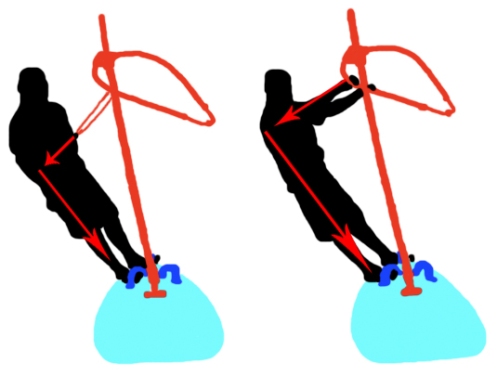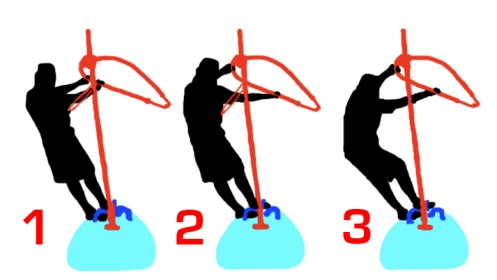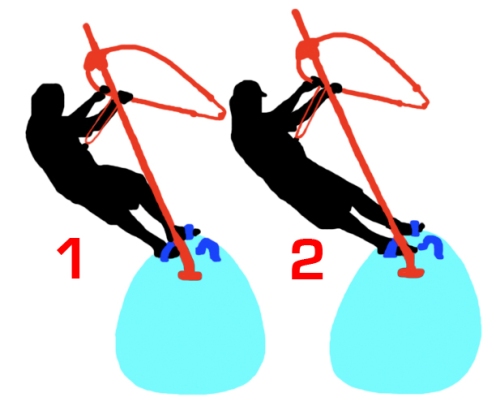STANCE.
STANCE.
………………… or maybe I should call it suspension, drive and balance.
Many have asked me to try and write down my little talks I have with them on the simulator, so here goes I will try.
First I must say a simulator is static with a static pull and simulates nothing that happens on the water but I love my simulators, as I can stand by who I am talking to and change the angles to explain different points.
Demonstrating on the water I have learnt I have my style, my small size (so use of smaller boards and rigs) and many tricks of the trade to make things work even when things go wrong.
So I am using my simulators more and more to explain things.
Learning is about finding and it is you that are asking to find. I go on the water every day trying to find answers.
SUSPENSION………………….. Being fully committed to the forces you are playing with.
DRIVE……………………………. All of the power is driving you forwards.
BALANCE……………………….. Controlling/adjusting body, rig and board to keep everything smooth and at the speed you are comfortable with.
I have been windsurfing since 1977 and the principle has not changed. We have our front triangle which drives the board forwards. All that has changed is the new equipment, allowing us to use it in a more efficient way.
In this article I am using graphics/painted out photos to talk about some points. The boom is level with the shoulders. From the first graphic you will see that when standing by the mast it seams to be quite high.
When we are in this position the mast is leaning away from us. We have power in the rig but we are also having to lean against the weight of the sail.
Personally I try not to alter the hight of my boom but there are situations where we need to gain control of one of the elements. So we will adjust boom hight and harness line length. The more over powered you are the lower the boom and the longer the lines.
Comfort and easy sailing is what we are looking for, suspension, everything straight, nice and relaxed, in and out of the harness. Here I am showing more the true angle we sail but our aim is always to have the mast as vertical as we can.
Learning to be 100 percent in the harness is very important, the drive is direct. Its so easy to keep the front leg straight. out of the harness it is more difficult to keep the body straight but you have a longer lever against the pull of the sail.
You can see that in 1.when the hands are closer together the arms are able to be straight, extending the upper body away from the rig.
In 2. the hands are wide apart, with the harness lines the same length, the upper body is closer to the rig. Giving the body a bend. This tends to make you use your arms more, say 80% harness 20% arms.
In 3. you can see by dropping the hips you will hold onto the power but the pressure will be all on the arms and you will need a lot of strength to hold the power. This is a position you get into when using a seat harness.
Which looks the most comfortable?
So working 100% with the nearness, closing and opening the sail is simple. The sail is pivoting around the harness lines. Having the lines close together will make that point more direct.
If I hold pressure with the back hand as in 1. The mast will go away from the wind (more upright) closing the sail. So in fact the sail closes it’s self.
Releasing the pressure with the back hand, 2. the mast will move towards the wind, opening the sail.
Having your hands closer together will give you a shorter pivot point, being similar to the harness line. 3. Releasing the pressure in the back hand and allowing the mast to move towards the wind opens the sail. Pressure in the back hand and allowing the mast to go away from the wind (more upright), the sail closes.
Another thing you will notice with your hand positions, is that the further apart they are the more the elbows go out. This automatically makes you grip harder causing the forearms to pump up. If you have your hands together the elbows will drop down, making it easier to release your grip and just use your fingers like a hook. Releasing all the pressure in the forearms.
This graphic shows 2 points.
I have another rule. Hips and shoulders always stay parallel to the boom. So if you bend the back leg, the hips will automatically turn forwards, also bringing your body further towards the back of the board. when you keep the shoulders at the same angle the sail will open. When you straighten your back leg, the hips go more parallel to the board. Closing the sail and bringing your weight forwards.
So if you are opening the sail due to to much force in the sail, allow the sail to pull you towards the centreline of the board. and forwards.( a totally opposite reaction to what your brain is telling you) The same reaction will happen when you straighten the back leg and your body goes forwards as you close the sail.
The other point is be careful of the angle of the sail towards the wind. The more you sail with the rig leaning towards the wind, the pressure you will be placing on the board sideways increases. This is a common problem people have with spin out problems. Many people will increase this problem by even bending the front leg, bring your body weight even more forewords and placing even more pressure on the back of the board.
These are just a few points for you to think about until we talk again when we take it further.






